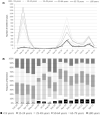SARS-CoV-2 infections in pediatric patients: A comparison of three pandemic waves
- PMID: 35080306
- PMCID: PMC9545555
- DOI: 10.1111/pai.13642
SARS-CoV-2 infections in pediatric patients: A comparison of three pandemic waves
Abstract
The pediatric population seems to be at a lower risk of developing severe clinical symptoms of COVID-19. However, the clinical and epidemiological characteristics of COVID-19 in children are yet to be fully clarified. This retrospective observational study aimed to evaluate the frequency of pediatric laboratory-confirmed COVID-19 patients from February 2020 to April 2021. A total of 740 (5.1% of total) pediatric COVID-19 cases were observed during the study period. The peak of pediatric cases was observed in November 2020, with 239 cases. During the first wave of pandemics, the frequency of pediatric cases was 0.89% (49/5877 cases), ranging from 0.6% in February 2020 to 1.3% in April 2020. On the contrary, after the beginning of the second wave, the frequency of pediatric cases raised from 5.3% in September 2020 to 9.4%in February 2021, with an overall frequency of 8.2% (690/8416 cases). A different rate of SARS-CoV-2 circulation was observed among the pediatric population between the pandemic waves. During the second wave, two peaks of cases were observed. The last peak was associated with the spread of a more transmissive SARS-CoV-2 strain (VOC 202012/01).
Keywords: COVID-19; SARS-CoV-2; epidemiology; pandemic; pediatric infection.
© 2022 The Authors. Pediatric Allergy and Immunology published by European Academy of Allergy and Clinical Immunology and John Wiley & Sons Ltd.
Conflict of interest statement
All authors have no conflicts of interest to disclose.
Figures

Similar articles
-
Can we get out of the COVID pandemic without adequate vaccination coverage in the pediatric population?Ital J Pediatr. 2022 Aug 19;48(1):150. doi: 10.1186/s13052-022-01339-x. Ital J Pediatr. 2022. PMID: 35986340 Free PMC article.
-
SARS-CoV-2 infection in patients with inflammatory bowel disease: comparison between the first and second pandemic waves.BMC Gastroenterol. 2023 Jul 5;23(1):230. doi: 10.1186/s12876-023-02841-0. BMC Gastroenterol. 2023. PMID: 37407913 Free PMC article.
-
[Experience in pediatric patients with COVID-19 during the first pandemic wave].Medicina (B Aires). 2022;82(3):332-337. Medicina (B Aires). 2022. PMID: 35639052 Spanish.
-
Management and outcomes of patients on maintenance dialysis during the first and second wave of the COVID-19 pandemic in Geneva, Switzerland.Swiss Med Wkly. 2021 Aug 27;151(33-34). doi: 10.4414/SMW.2021.w30006. Swiss Med Wkly. 2021. PMID: 34495598 Review.
-
COVID-19 and pediatric pulmonology: Feedback from an expert center after the first year of the pandemic.Pediatr Pulmonol. 2023 Feb;58(2):392-397. doi: 10.1002/ppul.26235. Epub 2022 Nov 22. Pediatr Pulmonol. 2023. PMID: 36353967 Free PMC article. Review.
Cited by
-
Characteristics of Hospitalized Pediatric Patients in the First Five Waves of the COVID-19 Pandemic in a Single Center in Poland-1407 Cases.J Clin Med. 2022 Nov 17;11(22):6806. doi: 10.3390/jcm11226806. J Clin Med. 2022. PMID: 36431283 Free PMC article.
-
Survival analysis and mortality predictors of COVID-19 in a pediatric cohort in Mexico.Front Public Health. 2022 Dec 16;10:969251. doi: 10.3389/fpubh.2022.969251. eCollection 2022. Front Public Health. 2022. PMID: 36589967 Free PMC article.
References
-
- WHO Coronavirus (COVID‐19) Dashboard (Accessed 15th April 2021). https://covid19.who.int
Publication types
MeSH terms
Grants and funding
LinkOut - more resources
Full Text Sources
Medical
Miscellaneous

